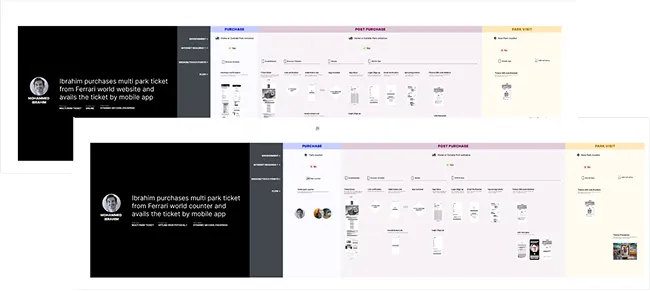Ticket Fraud Prevention

- Role: Digital Experience Manager
- Tools: Figma, Adobe suite, Miro, Microsoft clarity, Firebase, ChatGPT, Microsoft
I led the UX strategy to mitigate ticketing fraud in a theme park environment by transitioning from static tickets to secure, scalable alternatives. We introduced a multi-channel ticketing experience through dynamic QR codes, Face ID authentication, and counter-issued physical tickets to cater to diverse user needs—while ensuring zero fraud post-pilot.
Problem Statement
Business Goals / Needs / Pain points
- Eliminate fraud from static ticket misuse.
- Provide a secure, scalable, and user-friendly ticketing experience.
- Minimize friction for non-tech-savvy users.
- Ensure compliance with UAE legal frameworks for identity verification.
User Needs / Pain points
- Frictionless Entry Experience: Visitors want a hassle-free and smooth entry without delays, confusion, or long wait times.
- Clarity in Ticket Redemption: Users should clearly understand how to redeem their ticket—whether it's through a mobile app, Face ID, or physical ID verification.
- Accessible Solutions for All Personas: Non-digital users (e.g., senior citizens or large tour groups) need traditional options like counter-issued tickets with identity verification.
- Trust and Confidence: Users need to feel secure that their ticket is valid, protected, and easy to use without risk of being denied entry.
Challenges
- Last-minute Distribution: B2B tickets often handed out just before park entry, limiting time for secure personalization.
- Fragmented Channels: Tickets are purchased through website, call center, counters, and B2B partnerships, requiring a unified and flexible entry system.
- Balancing Security and Usability: New features like Face ID or QR codes must not alienate non-tech-savvy users.
- Personalized Solutions: One-size-fits-all doesn’t work; solutions must cater to diverse user personas and comfort levels.
- Digital tickets with dynamic QR codes for enhanced traceability
- Face ID integration to enable secure, contactless entry
- Printed tickets as an alternative for non-tech-savvy users
- I passively observed the end-to-end ticketing journey—from purchase to park entry and exit—to identify user pain points through empathy-driven insights.
- One key persona was B2B tourist groups (50–70 members), who typically receive static multi-day tickets at entry. Transitioning them to digital or Face ID-linked tickets proved challenging due to limited tech familiarity.
- This emphasized the need to design inclusive solutions for non-tech-savvy users and ensure a simplified, assisted journey for such groups.
- To uncover guest pain points and unmet needs, I created a Customer Journey Map by carefully mapping each interaction across the park’s touch points.
- This helped identify friction areas, understand user behavior at every stage, and inform experience improvements with greater clarity.
- Next, I conducted a detailed competitor analysis of Disney, Universal Studios, and Trope, focusing on their multi-day, multi-park ticketing systems.
- The study offered valuable insights into how large-scale parks balance security and usability effectively.
- Data revealed that while B2B contributes the majority of ticket sales, it also experiences a higher rate of fraud compared to B2C.
- This highlighted a critical need for targeted educational campaigns and onboarding support for B2B groups—especially large tour operators—to ensure secure and successful ticket redemption.
- By focusing on the most vulnerable segment, we aimed to reduce fraud while maintaining a frictionless experience.
-
In this phase my primary goal was to design a seamless, user-friendly ticketing experience across multiple touchpoints while ensuring legal compliance, technical feasibility, business viability, and usability.
Key Ticket Redemption Options (UAE-Compliant)
- Digital Ticket (Dynamic QR Code) – Mobile app-based activation with unique, secure QR codes.
- Face ID Ticketing – Facial recognition linked to the ticket for verification.
- Traditional Paper Tickets – Counter-issued, linked to government ID for non-tech-savvy users.
- Biometric Verification – Fingerprint/iris scanning (advanced but optional).
- Time-Stamped Photos – Entry photos for multi-day verification (optional).
(First three were prioritized for legal compliance in the UAE.)
Design Approach
- Feasibility – Aligned with current tech & infrastructure.
- Business Viability – Budget-friendly & sustainable.
- User Usability – Intuitive & accessible for all users.
(The "sweet spot" where these three overlap guided the final design.)
Brainstorming
Collaborative Brainstorming with Cross-Functional Teams, Operational Leaders, and All Business Stakeholders—including ChatGPT Insights
Designing for Multiple Clients and Mediums
- Website (B2B/B2C purchases) → Mobile App → Email (PDF tickets) → Kiosks/Turnstiles.
- Unified experience with flexibility for different user preferences.
Scenario-Based User Journeys
- Online purchases (B2C & B2B).
- Call center bookings.
- Walk-in counter transactions.
Designed for multiple permutations to avoid friction.

Creating Marketing & Educational Materials
Digital & physical guides to educate users on redemption. Strategic placement in high-traffic website areas (based on analytics).
Used banners & campaigns on top-viewed pages to maximize visibility & adoption.

-
- Developed and tested multiple design directions—from low to high-fidelity prototypes—while formulating hypotheses to guide decision-making.
- Close collaboration with cross-functional teams and stakeholders enabled rapid validation and iterative refinement of the user experience.


Design Tools & Deliverables
- Primary Tool: Figma (wireframes, high-fidelity designs, prototypes).
- Supporting Tools: Adobe Suite.
- Design Delivery: Shared in flexible formats for cross-team collaboration.

Design System Custodian
- Maintained consistency across components, styles, and reusable assets across different client brands.
- Ensured adherence to brand guidelines and UI/UX best practices across industries.
Delivery to Development
- Provided annotated designs with detailed notes on interactions, animations, and logic.
- Facilitated smooth handoff by clarifying design intent and technical requirements.
Accessibility & Multilingual Support
- Basic WCAG compliance (contrast, text sizing) despite limited company focus.
- Dual-language (RTL/LTR) support with adaptable layouts for text expansion.
-
Business Impact
- Fraud Prevention: Implemented three ticketing methods: dynamic QR codes, Face ID linking, and traditional paper tickets. Achieved zero percent fraud incidents during pilot phase. Successfully transitioned from static, vulnerable ticketing model to secure digital platform.
- User Data Collection: Enabled user registration through mobile sign-ups. Provided discount incentives on food purchases upon entry. Collected valuable user data for data science activities and targeted marketing efforts.
- Analytics/Performance: 100% fraud reduction from previous static ticket system. Improved user engagement through incentivized registration. Enhanced data collection capabilities for future analysis. Successful multi-platform implementation (website, mobile app, kiosks).

User Impact
- Usability vs. Security Trade-off: Balanced enhanced security with user convenience. Introduced additional steps (Face ID linking, mobile app registration) for fraud elimination. Maintained seamless user flow despite increased security measures. Prioritized user trust through transparent security benefits.
- User Education and Adaptation: Implemented comprehensive user education campaigns. Provided in-app guidance and marketing materials. Successfully mitigated friction through proactive communication. Promoted positive experience despite additional user effort.

-

Key Lessons Learned
- Balancing Security with Usability: Successfully introduced additional security steps while maintaining user experience. Learned that user trust and security are crucial for long-term success. Clear communication helps users adapt to more complex processes. Security enhancements require proactive user education.
- User Education is Crucial: Early communication through in-app guidance and marketing materials essential. New technology adoption requires preparation and education. Proactive user education ensures smoother adoption and fewer roadblocks. Users adapt well when they understand the benefits of added security.
- Adaptability to User Needs: Designed for multiple user personas with varying tech proficiency levels. Tech-savvy users easily adopted digital and Face ID systems. Non-tech-savvy users required traditional paper ticket options. Importance of inclusive design for diverse user capabilities.
- Iterative Design and Continuous Feedback: Failing fast and adjusting quickly proved valuable. Continuous iterations based on cross-functional team feedback. Early adjustments in prototyping phase prevented major setbacks. Real-time collaboration essential for aligned technical and UX outcomes.
Challenges
- Pilot phase metric limitations - comprehensive tracking across platforms challenging
- Technology constraints influenced design choices and system flow
- Multiple client sign-offs added complexity to decision-making process
- Balancing different medium requirements (web, mobile, kiosks) required careful coordination
What Went Well
- Multi-layered security approach successfully eliminated fraud
- Adaptive design strategy accommodated different user personas
- Cross-functional collaboration with development, testing teams, and business
- Iterative design process enabled quick adjustments and refinements
I collaborated with management and proposed a shift to a more secure system through a vetted vendor solution.
AS-IS Analysis
I began the discovery phase by analyzing the AS-IS ticketing process, mapping out the current user journey to identify pain points and opportunities for improvement.

Ethnographic Study & Persona Analysis
Customer Journey Map
Competitor Analysis
Indirect Competitor Analysis
Conducted an indirect competitor analysis to explore experiences from parallel industries, aiming to identify innovative practices and user-friendly solutions that could be adapted to enhance the ticketing journey.

